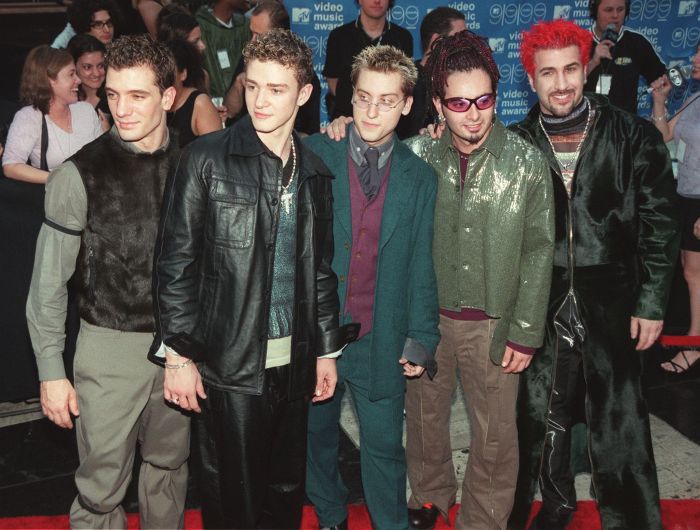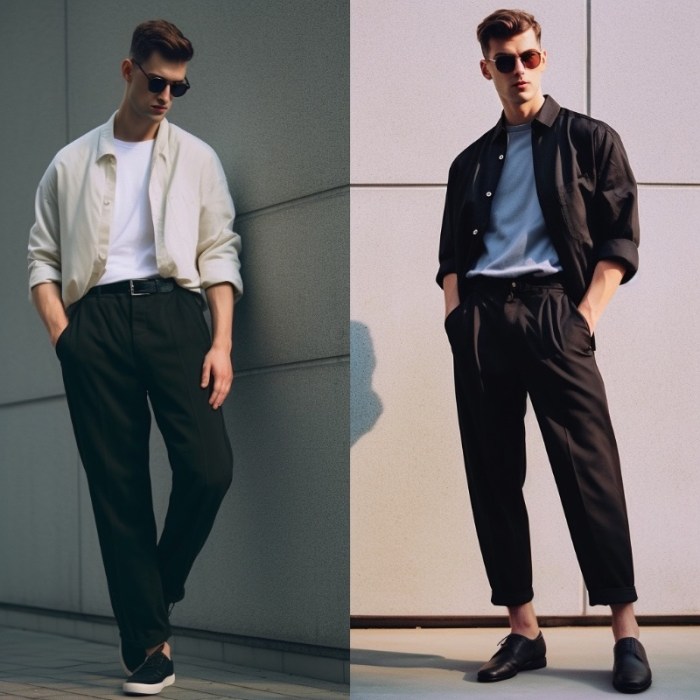Mens 60s Fashion A Style Retrospective
Defining 60s Men’s Fashion
Men’s 60s fashion – The 1960s witnessed a dramatic shift in men’s fashion, moving away from the conservative styles of previous decades and embracing a wider range of influences and aesthetics. This era saw the rise of diverse subcultures, each with its own unique fashion identity, leading to a period of experimentation and stylistic innovation.
Key Characteristics of 1960s Men’s Fashion
Several key characteristics defined 1960s menswear. Slimmer silhouettes replaced the broader, more structured looks of the 1950s. Bold colors and patterns became increasingly popular, reflecting the optimism and social change of the era. New fabrics, such as synthetic materials like polyester, emerged, offering a wider array of textures and possibilities for design. The rise of youth culture significantly impacted fashion, leading to the adoption of more casual and rebellious styles.
Major Sub-trends in 60s Menswear
The 1960s saw the emergence of several distinct sub-trends, each catering to different tastes and lifestyles. The Mod style, originating in Britain, emphasized sharp tailoring, clean lines, and bold colors. The Ivy League style, influenced by the preppy aesthetic of American universities, featured button-down shirts, chinos, and blazers. Other notable trends included the psychedelic styles associated with the counterculture movement, characterized by vibrant colors, paisley patterns, and flowing fabrics.
Comparison with Preceding Decades
Compared to the 1950s, 60s menswear was significantly more diverse and less restrictive. The conservative suits and ties of the previous decade gave way to a wider range of options, including more casual and expressive styles. The silhouette shifted from broader shoulders and a fuller cut to a slimmer, more youthful look. The use of color and pattern also increased dramatically, reflecting a departure from the more muted palettes of the 1950s.
Dominant Silhouettes, Colors, and Fabrics of the 1960s
| Silhouette | Colors | Fabrics |
|---|---|---|
| Slim fitting, tailored suits; slim-fitting shirts; relaxed casual wear | Bold primary colors; pastel shades; earth tones; psychedelic patterns | Wool; cotton; linen; synthetic fabrics like polyester and nylon |
Iconic Garments and Accessories: Men’s 60s Fashion
Certain garments and accessories became synonymous with 1960s men’s fashion, shaping the overall aesthetic of the era and reflecting the evolving social landscape.
The Evolution of the Tailored Suit
The tailored suit, a staple of men’s fashion, underwent a transformation in the 1960s. While still a significant garment, particularly in more formal settings, the suit became slimmer and more streamlined, reflecting the changing times. The use of bolder colors and patterns also became more common, departing from the traditional somber hues.
The Rise of Casual Wear
The 1960s witnessed a significant rise in casual wear, particularly among younger generations. This shift was fueled by youth culture and a growing rejection of traditional formality. Items like jeans, t-shirts, and sweaters gained popularity, reflecting a more relaxed and informal approach to men’s fashion.
The Role of Accessories
Accessories played a crucial role in defining 60s style. Ties, often in bold patterns or colors, added a touch of personality to more formal outfits. Hats, ranging from fedoras to berets, were popular headwear choices. Shoes, such as loafers and boots, complemented the overall look, reflecting the diversity of styles prevalent during the decade.
A Typical 60s Male Outfit
Imagine a young man sporting a slim-fitting, possibly brightly colored, suit with a button-down shirt underneath. He might be wearing a patterned tie, a fedora perched jauntily on his head, and a pair of polished loafers on his feet. Alternatively, a more casual look might consist of well-fitting jeans, a polo shirt, and a leather jacket, perhaps paired with boots.
Cultural Influences on Menswear

Source: imgix.net
The cultural landscape of the 1960s profoundly impacted men’s fashion, reflecting the social, political, and musical changes of the era. These influences shaped the styles and trends that defined the decade’s menswear.
Music and Youth Culture’s Impact
The burgeoning music scene, particularly the British Invasion and the rise of rock and roll, heavily influenced 60s menswear. The Mod style, for instance, was directly linked to the music scene, emphasizing sharp tailoring and a sophisticated look. The counterculture movement also impacted fashion, with its embrace of more bohemian and unconventional styles.
Social and Political Movements’ Influence
Social and political movements, such as the civil rights movement and anti-war protests, indirectly influenced fashion choices. The desire for self-expression and individuality led to a rejection of traditional norms, fostering experimentation with clothing styles and a move toward more casual and expressive looks.
Media’s Role in Popularizing Styles
Film and television played a significant role in popularizing 60s styles. Iconic films and television shows showcased various fashion trends, influencing the choices of viewers and contributing to the widespread adoption of certain looks. This helped solidify the fashion trends of the era and make them accessible to a wider audience.
Timeline of Major Fashion Shifts, Men’s 60s fashion
A timeline illustrating major fashion shifts would include the early 60s’ conservative styles gradually giving way to the more experimental looks of the mid-to-late 60s, coinciding with the rise of youth culture and social movements. Key moments could include the British Invasion’s impact on Mod fashion and the increasing influence of counterculture styles.
The Evolution of Menswear Through the 60s
Men’s fashion in the 1960s wasn’t static; it evolved throughout the decade, reflecting changing social attitudes and the rise of diverse subcultures. The transition from conservative to more experimental styles was a gradual yet significant process.
Men’s 60s fashion was a fascinating blend of tailored suits and burgeoning youth styles. Understanding the nuances of that era, from the slim-fitting silhouettes to the bold patterns, requires a keen eye for detail. This is where resources like teaching men fashion testoserone can be invaluable, offering insights into the underlying principles of masculine style. Ultimately, mastering the art of 60s menswear allows for a confident and stylish expression of personal taste.
Changes from Early to Late 1960s
The early 1960s still retained elements of the previous decade’s conservative style. However, as the decade progressed, slimmer silhouettes, bolder colors, and more casual options gained popularity. The late 1960s saw the peak of experimentation, with the rise of psychedelic styles and a more pronounced rejection of traditional formality.
Transition from Conservative to Experimental Looks
The shift from conservative to experimental styles was gradual, influenced by several factors. The rise of youth culture, the influence of music, and social and political movements all contributed to this transformation. This transition marked a significant change in men’s fashion, paving the way for the more diverse and individualistic styles of subsequent decades.
Styles of Different Social Groups
Different social groups adopted various styles during the 1960s. The working class might have embraced more practical and durable clothing, while the affluent might have favored tailored suits and high-end accessories. Youth culture, however, transcended class boundaries, leading to a shared adoption of certain styles among diverse social groups.
Influence of International Fashion Trends
International fashion trends significantly impacted American menswear during the 1960s. The British Mod style, for instance, had a considerable influence on American fashion, demonstrating the cross-cultural exchange and the global reach of fashion trends.
The Lasting Legacy of 60s Men’s Fashion

Source: thefashionisto.com
The impact of 1960s menswear extends far beyond the decade itself, with many elements continuing to influence contemporary fashion. Several key trends and styles have experienced revivals and reinterpretations in modern clothing.
Elements Influencing Contemporary Fashion
Many elements of 1960s menswear continue to inspire designers today. The slim-fitting silhouette, bold colors, and the emphasis on individual expression remain relevant. The reinterpretation of classic garments like the tailored suit and the integration of casual wear into more formal settings are testaments to the enduring influence of 60s fashion.
Reinterpretations and Revivals
Designers regularly draw inspiration from the 1960s, reinterpreting classic styles for modern audiences. This includes reimagining tailored suits with slimmer fits and bolder colors, incorporating psychedelic patterns into contemporary designs, and updating classic accessories for a contemporary feel.
Enduring Appeal of Specific Garments and Accessories
Certain garments and accessories from the 1960s maintain their enduring appeal. The tailored suit, though updated for modern sensibilities, remains a staple of men’s fashion. The leather jacket, a symbol of rebellion and cool, continues to be a popular choice. Similarly, certain shoe styles and accessories from the era have also found their way into contemporary wardrobes.
60s Trends Still Visible in Modern Men’s Fashion
- Slim-fitting silhouettes
- Bold colors and patterns
- The tailored suit (reinterpreted)
- Leather jackets
- Casual wear integrated into formal settings
FAQ Insights
What were some common fabrics used in men’s 60s fashion?
Common fabrics included wool (for suits), cotton (for shirts and casual wear), linen (for summer clothing), and synthetic materials like polyester, which were becoming increasingly popular.
How did the Vietnam War influence men’s fashion?
The war indirectly influenced fashion through the rise of anti-establishment sentiment. This contributed to the popularity of more casual and less formal styles, reflecting a rejection of traditional norms.
Were there any notable men’s fashion icons of the 60s?
Yes, icons included musicians like The Beatles and The Rolling Stones, whose styles heavily influenced youth fashion. Actors like Steve McQueen also contributed to defining the era’s aesthetic.











